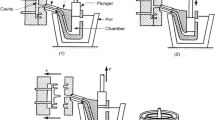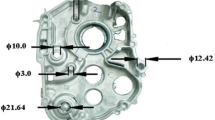Abstract
Hot chamber die casting (HCDC) process is designed to achieve high dimensional accuracy and surface hardness (SH) for industrial applications (like machine tool components). In the present study, outcome of Taguchi model has been used for developing a mathematical model for SH; using Buckingham’s π-theorem for HCDC process. Three input parameters namely pressure at 2nd phase; metal pouring temperature and die opening time were selected to give output in form of SH. This study will provide main effects of these variables on SH and will shed light on the casting hardness mechanism in HCDC process. The comparison with experimental results will also serve as further validation of model.
Similar content being viewed by others
References
Yoshihiko and Soichiro, Quantitative evaluation of porosity in aluminium alloy dies castings by fractal analysis of spatial distribution of area, Material and design, 30 (2009) 1169–1173.
O. Mizuno, and Hitomi Yamazaki, Comparison of mechanical properties of die cast aluminium alloys: cold v. hot chamber die casting and high v. low speed filling die casting, International Journal of Cast Metals Research, 22 (2009) 374–381.
I. Rosindale and K. Davey, Transient thermal model for the hot chamber injection system in the pressure die casting process, Applied mathematical modeling, 23 (1999) 255–277.
Sabau and Dinwiddie, Characterization of spray lubricants for the high pressure die casting processes, Journal of Materials Processing Technology, 195 (2008) 267–274.
Lee, Patel and Gokhale, Characterization of the effects of process parameters on macro segregation in a high-pressure die-cast Magnesium alloy, Materials Characterization, 55 (2005) 219–224.
Long, Thornhill, Cecil and Watson, Determines of the heat transfer coefficient at the metal die interface for high pressure die cast AlSi9Cu3Fe, Applied Thermal Engineering, 31 (2011) 3996–4006.
L. Kumar, Multi-response optimization of process parameters in cold chamber pressure die casting. Thesis, Department of Mechanical Engineering, Thapar University Patiala, India (2010) 23–61.
L. Cerri and Marco, Hot compression behavior of the AZ91 magnesium alloy produced by high pressure die casting, Journal of materials processing technology, 189 (2008) 97–106.
H. T. Domkin, Investigates soldering of cast alloys to the dies continuing source of die surface damage in the aluminium die casting, Journal of material processing technology, 209 (2008) 4051–4061.
D. D. Dourb and G. Savaged, The influence of pressure during solidification of high pressure die cast aluminium telecommunication components, Journal of materials processing technology, 180 (2006) 37–43.
Hallam and Griffiths, A model of interfacial heat transfer coefficient for the aluminium die casting process, Metallurgical and materials transactions, 35B (2004) 723.
R. Singh and R. Kapoor, Effect of pressure on casting properties in cold chamber die casting, Lambert Academic Publishing AG & Co. KG, Saarbrücken, Germany, ISBN 978-3-659-12721-2 (2012).
R. Singh and H. Singh, Effect of some parameters on properties of hot chamber die casting, Lambert Academic Publishing AG & Co. KG, Saarbrücken, Germany, ISBN 978-3-659-13087-8 (2012).
D. D. Dourb and G. Savaged, The influence of pressure during solidification of high pressure die cast aluminium telecommunication components, Journal of materials processing technology, 180 (2006) 37–43.
Kiełbus, Microstructure of AE44 magnesium alloy before and after hot-chamber die casting, Journal of achievements in materials and manufacturing Engineering, 20 (2007) 459–464.
G. N. Kong and Hodgson, Integrated optimization system for high pressure die casting processes, Journal of materials processing technology, 201 (2008) 629–634.
Yarlagadda and Chiang, A neural network system for the prediction of process parameters in pressure die casting, Journal of Materials Processing Technology, 90 (1999) 583–590.
C. Zhu and Maijer, Modelling of micro porosity formation in A356 Aluminium Alloy Casting, Metallurgical and materials transactions A, 37 (2006) 1075.
H. Lifang, C. Shaoping, M. Yang and M. Qingsen, Diecasting effect on surface characteristics of thin-walled AZ91D magnesium components, Applied Surface Science, 261 (2012) 851–856.
A. L. Alan, Magnesium casting technology for structural applications, Journal of Magnesium and Alloys (2013) In Press.
J. Jufu, W. Ying, L. Yuanfa, Q. Jianjun, S. Weiwei and L. Shoujing, A double control forming technology combining die casting and forging for the production of Mg alloy components with enhanced properties, Journal of Materials Processing Technology, 212(5) (2012) 1191–1199.
R. Singh and J. S. Khamba, Mathematical modeling of tool wear rate in ultrasonic machining of titanium, The International Jol. of Advanced Manufacturing Technology, 43(5–6) (2009) 573–580.
R. Singh and J. S. Khamba, Mathematical modeling of surface roughness in ultrasonic machining of titanium using Buckingham-Π approach: A Review, International Jol. of Abrasive Technology, 2(1) (2009) 3–24.
Author information
Authors and Affiliations
Corresponding author
Additional information
Recommended by Associate Editor Dae-Cheol Ko
Rupinder Singh is Professor in the Department of Production Engineering at Guru Nanak Dev Engineering College, Ludhiana, India. He completed his B.Tech. in Production Engineering with Honours and M.Tech. in Production Engineering with Gold Medal from P.T.U. Jalandhar. He obtained a Ph.D. (Engineering) from T.I.E.T. Patiala. He is a member of ASME, ISTE, ISME, MPAS, ISC and AIE. He has contributed about 220 research papers at the National and International level and supervised 70 M.Tech. theses. His areas of interest include rapid prototyping, non-traditional machining, maintenance engineering and welding.
Rights and permissions
About this article
Cite this article
Singh, R. Modeling of surface hardness in hot chamber die casting using Buckingham’s π approach. J Mech Sci Technol 28, 699–704 (2014). https://doi.org/10.1007/s12206-013-1133-4
Received:
Revised:
Accepted:
Published:
Issue Date:
DOI: https://doi.org/10.1007/s12206-013-1133-4




